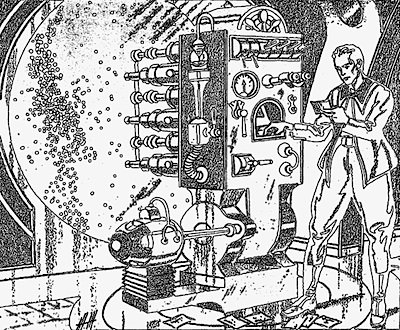Science Fiction
Dictionary
A B C D E F G H I J K L M N O P Q R S T U V W X Y Z
Starshade Will Help Space Telescope To Search For Exoplanets

A starshade would accompany a future space telescope and block the light of an individual star to enhance the study of exoplanets orbiting that star.
A future starshade mission would involve two spacecraft. One would be a space telescope on the hunt for planets orbiting stars outside of our solar system. The other spacecraft would fly some 25,000 miles (40,000 kilometers) in front of it, carrying a large, flat shade. The shade would unfurl like a blooming flower — complete with "petals" — and block the light from a star, allowing the telescope to get a clearer glimpse of any orbiting planets. But it would work only if the two spacecraft were to stay, despite the great distance between them, aligned to within 3 feet (1 meter) of each other. Any more, and starlight would leak around the starshade into the telescope's view and overwhelm faint exoplanets.(Via NASA: Starshade Would Take Formation Flying to Extremes.)
In his thrilling 1936 story Cosmic Quest, Golden Age phenom Edmond Hamilton created an elaborate device to search for habitable planets:
And each mechanical eye, when it found planetary systems in its field, automatically shifted upon them a higher powered telespectroscope which recorded on permanent film the size, mean temperature and atmospheric conditions of these worlds.
(The telespectroscope recorded the conditions of these other worlds)(Read more about the telespectroscope)
Speaking of Thrilling Wonder Stories, take a look at these real life wonder stories of the search for habitable exoplanets:
- Looking For Earth-Like Worlds With Nulling Interferometry
- Europe's Cheops To Look For Habitable Planets
- Automated Planet Finder Telescope Starts The Hunt
- NASA’s Transiting Exoplanet Survey Satellite (TESS) Looks Nearby
- Confirm 100 Exoplanets At Once! (With Video)
- Caltech's ET Laboratory Looks For New Earths
- Rapid Automated Search For Habitable Planets Needed
- Espresso Telescope Searches For Exoplanets
Scroll down for more stories in the same category. (Story submitted 6/7/2019)
Follow this kind of news @Technovelgy.| Email | RSS | Blog It | Stumble | del.icio.us | Digg | Reddit |
Would
you like to contribute a story tip?
It's easy:
Get the URL of the story, and the related sf author, and add
it here.
Comment/Join discussion ( 0 )
Related News Stories - (" Space Tech ")
Will Space Stations Have Large Interior Spaces Again?
'They filed clumsily into the battleroom, like children in a swimming pool for the first time, clinging to the handholds along the side.' - Orson Scott Card, 1985.
Reflect Orbital Offers 'Sunlight on Demand' And Light Pollution
'I don't have to tell you about the seven two-mile-diameter orbital mirrors...'
Chrysalis Generation Ship to Alpha Centauri
'This was their world, their planet —
this swift-traveling, yet seemingly moveless vessel.' - Nat Schachner, 1934
The First Space Warship For Space Force
'Each of the electrical ships carried about twenty men...' - Garrett P. Serviss, 1898.
Technovelgy (that's tech-novel-gee!) is devoted to the creative science inventions and ideas of sf authors. Look for the Invention Category that interests you, the Glossary, the Invention Timeline, or see what's New.
Science Fiction
Timeline
1600-1899
1900-1939
1940's 1950's
1960's 1970's
1980's 1990's
2000's 2010's
Current News
Natural Gait With Prosthetic Connected To Nervous System
'The leg was to function, in a way, as a servo-mechanism operated by Larry’s brain...'
Woman Marries Computer, Vonnegut's Dream Comes True
'Men are made of protoplasm... Lasts forever.'
Spidery 'Walk Me' Toyota Autonomous Wheel Chair Like Star Wars
Walk along with the emperor.
Dancing Robots Taught Dance Moves
'A clockwork figure would be the thing for you...'
Proof Of Robothood - Not A Person
'Who are you people? - Show 'em.'
Indonesian Clans Battle
'The observation vehicle was of that peculiar variety used in conveying a large number of people across rough terrain.'
The 'Last Mile' In China Crowded With Delivery Robots
Yes, it's a delivery robot. On wheels.
Tornyol Microdrone Kills Mosquitoes
'The real border was defended by... a swarm of quasi-independent aerostats.'
PLATO Spacecraft, Hunter Of Habitable Planets, Now Ready
'I ... set my automatic astronomical instruments to searching for a habitable planet.'
Factory Humanoid Robots Built By Humanoid Robots
'...haven't you a section of the factory where only robot labor is employed?'
iPhone Air Fulfils Jobs' Promise From 2007 - A Giant Screen!
'... oblongs were all over the floor and surfaces.'
ChatGPT Now Participates in Group Chats
'...the city was their laboratory in human psychology.'
iPhone Pocket All Sold Out!
'A long, strong, slender net...'
Did The Yautja Have These First?
What a marvel of ingenuity the little device was!
Jetson ONE Air Races Begin, Can Air Polo Be Far Behind?
'If you're one of those rarities who haven't attended a rocket-polo "carnage", let me tell you it's a colorful affair.'
Will Space Stations Have Large Interior Spaces Again?
'They filed clumsily into the battleroom, like children in a swimming pool for the first time, clinging to the handholds along the side.'

